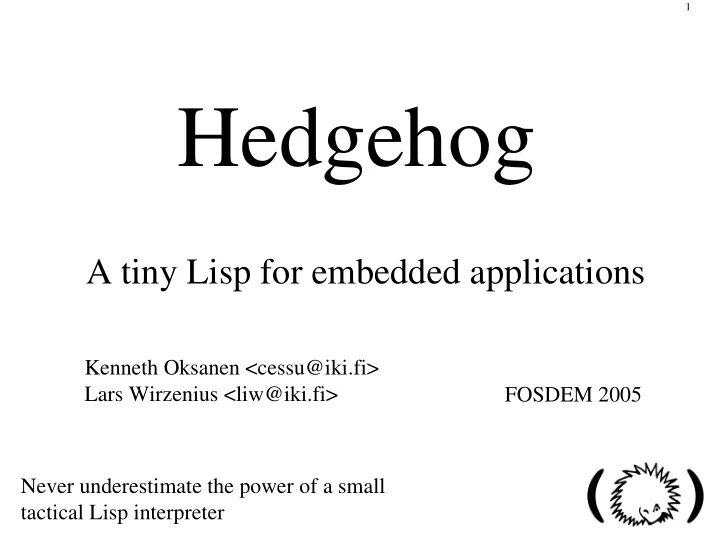

1 Hedgehog A tiny Lisp for embedded applications Kenneth Oksanen <cessu@iki.fi> Lars Wirzenius <liw@iki.fi> FOSDEM 2005 Never underestimate the power of a small tactical Lisp interpreter
2 A typical Oliotalo system ● Embedded boxes gather data, send to server ● Users interact with server – One server, many embedded boxes ● Communication via SMS, GPRS, Bluetooth, ... – Anything wireless – Low assumptions: not connection oriented, high failure rate, low bandwidth, expensive
3 A typical box for Oliotalo ● Not puny, not studly – ARM7 or better – Usually at least 256 kB memory – Flash or other persistent storage ● Most common model in 2002: operating system and application code statically linked together, flashed to box as an atomic unit – Big problems when application is updated
4 Language requirements ● 32-bit integers ● Reasonably fast ● Simple to port/implement, easy to maintain ● Easy to bind to operating system services and otherwise support everything the box can do ● App development efficient: high level language – Garbage collection!
5 Why Lisp? ● Simple syntax, simple semantics, very powerful – easy to implement, little code – gc, functional programming – Lasu had been reading Paul Graham... ● Our own implementation – easy to adapt to hardware, operating system – easier to achieve small size, speed – some NIH involved, admittedly
6 The timeline ● Fall of 2002: conception, prototype, first real use – concept is good, implementation is slow ● Late spring 2003: re-implementation – Cessu brought in, 600 times faster ● Summer 2003 - now: production use, tweaking – mostly adaptation to platform, language itself worked the first time – however, adaptation is hard, ugly work ● Winter 2005: free release 2.0
7 Current implementation ● Compiler on desktop – no linking, compiles full library every time (1 sec) ● Byte code file – very compact coding, specific to interpreter version (no codes for things not in a particular box) ● Byte code interpreter, desktop and box – simple stop© two semispace garbage collection ● Library – completely separate from interpreter
8 Example: hello, world (pr "hello, world")
9 Language features ● Simple data types: 32-bit integers, strings, symbols ● Constructs: singly linked lists, tuples, AVL trees – lists constructed from cons cells (value pairs, 2-tuples) nil 2 1 ● Lisp syntax: (funcname arg1 arg2 arg3)
10 Example: List length (bad) (def (list-len list) (if (nil? list) 0 (+ 1 (list-len (cdr list))))) Looping via recursion. Tail recursion is removed, no speed/space penalty.
11 Example: List length (good) (def (list-len list) (def (helper list length) (if (nil? list) length (tailcall (helper (cdr list) (+ length 1))))) (helper list 0)) Look at those parentheses!
12 Example: Unit testing (fail-unless-equal (list-len nil) 0) (fail-unless-equal (list-len '(1)) 1) (fail-unless-equal (list-len '(1 2)) 2) (fail-unless-equal (list-len '(1 2 3)) 3) Technically "function testing" since Hedgehog does not have modules as such.
13 The library ● Stuff that is useful to many applications ● String manipulation ● Simple math ● Lists, dictionaries/maps (via AVL trees) ● State machines, for simulating threads/tasks – No locking, less error prone than real threads ● More to be added as needed – Oliotalo has some private ones
14 Experiences ● Language design is fun – implementation mostly easy, too, the real work is supporting everything the platform provides ● Interpreter should be a thin layer – thin means less can go wrong – nice abstractions built with Lisp – repeatedly learned
15 Experiences ● Simulation environment on desktop is really nice – easier, faster to test and debug – programs run faster, too ● Lisp programming is easy, avoids typical C errors – has errors all its own: dynamic type checking...
16 Experiences ● Customers really love the flexibility to change things later – on the other hand, they will make use of this... – customers want early prototypes on-site, leading to many amusing anecdotes about debugging (axles, LED colors, wireless networks, ...) – easy to impress with fast turnaround
17 Future ● Maintain momentum ● Compiler optimizations ● Libraries ● Applications ● Ports ● Static typing?
18 Thank you http://hedgehog.oliotalo.fi hedgehog@hedgehog.oliotalo.fi
Recommend
More recommend